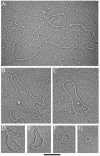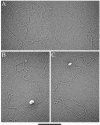Telomeric DNA in ALT cells is characterized by free telomeric circles and heterogeneous t-loops
- PMID: 15509797
- PMCID: PMC525488
- DOI: 10.1128/MCB.24.22.9948-9957.2004
Telomeric DNA in ALT cells is characterized by free telomeric circles and heterogeneous t-loops
Abstract
A prerequisite for cellular immortalization in human cells is the elongation of telomeres through the upregulation of telomerase or by the alternative lengthening of telomeres (ALT) pathway. In this study, telomere structure in multiple ALT cell lines was examined by electron microscopy. Nuclei were isolated from GM847, GM847-Tert, and WI-38 VA13 ALT cells, psoralen photo-cross-linked in situ, and the telomere restriction fragments were purified by gel filtration chromatography. Examination of telomere-enriched fractions revealed frequent extrachromosomal circles, ranging from 0.7 to 56.8 kb. t-loops were also observed, with the loop portion ranging from 0.5 to 70.2 kb. The total length of the loop plus tail of the t-loops corresponded to the telomere restriction fragment length from the ALT cell lines as determined by pulsed-field gel electrophoresis. The presence of extrachromosomal circles containing telomeric DNA was confirmed by two-dimensional pulsed-field gel electrophoresis. These results show that extrachromosomal telomeric DNA circles are present in ALT nuclei and suggest a roll-and-spread mechanism of telomere elongation similar to that seen in previous observations of multiple yeast species. Results presented here also indicate that expression of telomerase in GM847 cells does not affect t-loop or extrachromosomal circle formation.
Figures






References
-
- Bechter, O. E., J. W. Shay, and W. E. Wright. 2004. The frequency of homologous recombination in human ALT cells. Cell Cycle 3:547-549. - PubMed
-
- Bechter, O. E., Y. Zou, W. Walker, W. E. Wright, and J. W. Shay. 2004. Telomeric recombination in mismatch repair deficient human colon cancer cells after telomerase inhibition. Cancer Res. 64:3444-3451. - PubMed
-
- Bodnar, A. G., M. Ouellette, M. Frolkis, S. E. Holt, C. P. Chiu, G. B. Morin, C. B. Harley, J. W. Shay, S. Lichtsteiner, and W. E. Wright. 1998. Extension of life-span by introduction of telomerase into normal human cells. Science 279:349-352. - PubMed
-
- Bryan, T. M., A. Englezou, L. Dalla-Pozza, M. A. Dunham, and R. R. Reddel. 1997. Evidence for an alternative mechanism for maintaining telomere length in human tumors and tumor-derived cell lines. Nat. Med. 3:1271-1274. - PubMed
Publication types
MeSH terms
Substances
Grants and funding
LinkOut - more resources
Full Text Sources
Other Literature Sources
